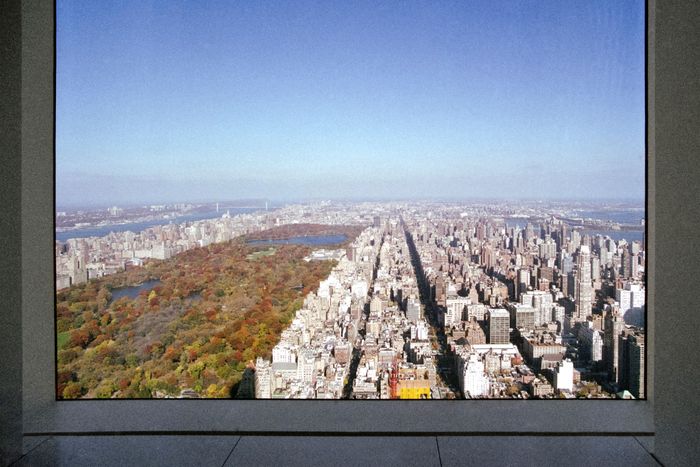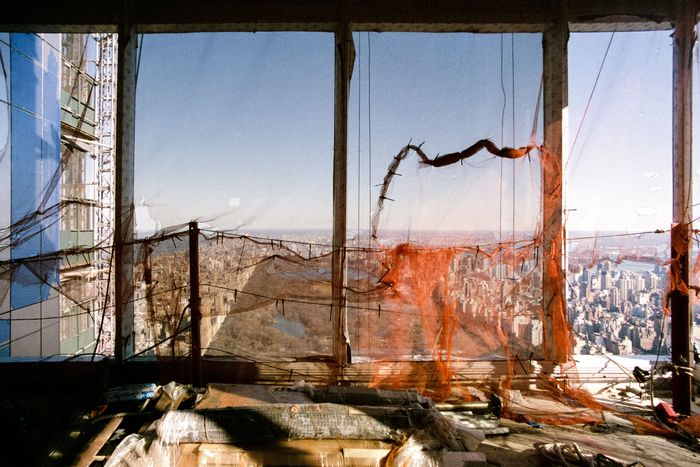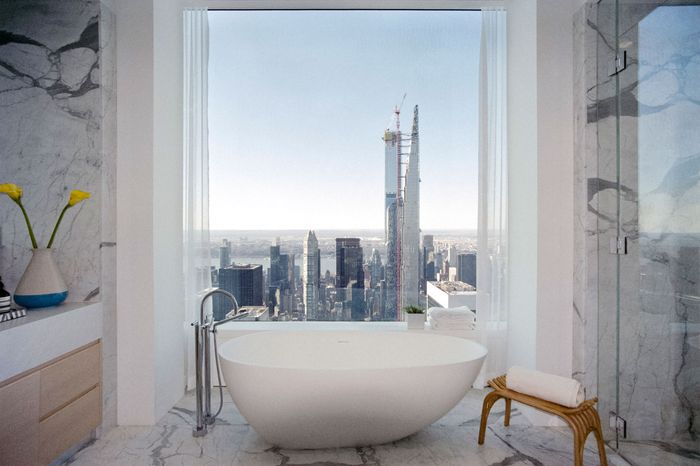
Andi Schmied is a young artist and architect from Budapest, and last year, during a New York artist residency at Dumbo’s Triangle Arts Association, she found herself wondering what the vistas were like from those new condo towers that line Billionaires’ Row. In order to talk her way in, she recast herself as a fictional, ultrawealthy Hungarian buyer to persuade real-estate agents to show her 25 of those sky-high luxury apartments, and then photographed the cityscape from all of them. You will soon be able to see the vistas yourself in Private Views: A High-Rise Panorama of Manhattan, a book of the pictures she took, its publication supported by a crowdfunding campaign, the Trapéz gallery in Budapest, the Future Architecture Platform, and the Graham Foundation. She spoke to Curbed about how, exactly, she persuaded the representatives of some of New York’s most expensive properties that she was an artsy Central European billionaire.
Christopher Bonanos: Tell me where this idea started.
Andi Schmied: With the biggest cliché! Just like any tourist who goes to New York I went up to the Empire State Building and was amazed at the view — and after gazing at those little people and cars on the street, I started to look at my eye level, and slowly started to see that there are quite a few buildings that are as tall as the Empire State Building or even taller.
And they’re almost all new.
Exactly. So I thought, I would like to see the city from all those different perspectives, and I started to walk the streets and list the buildings from street level. And then I was very quick to realize that those buildings are all luxury residential high rises. And I started to think, I don’t have too many choices — how do I get up there? As a Hungarian artist spending a very limited amount of time in New York, either I forget about it, or do something to myself to become someone who gets access. That’s when I realized that my only chance was to pretend that I want to either rent or purchase an apartment.
I obviously built a persona, because my real persona would not be granted access. Basically the way it worked was I called up the first agency asking, “I would like to see this property.” And I had to respond immediately to whatever they asked. The first question — it’s funny what it was — was “can you give us the name of your husband?” This came back many, many times, this question.
And so I realized that, okay, I’d need someone who is Googleable and is reasonably believable at this price point I was looking at. So I have a very good friend in Budapest, an antiquarian and a gallerist — he wouldn’t be able to afford those apartments but he has professional websites that somehow put him in this sphere of “well … maybe.”
He could pass.
He passed the first checkout. Also, I had to have a slightly modified name, just because if they’d check my real name, they’d find my art projects in luxury villas in China, which, I don’t know, would make me very suspicious as a potential buyer. So my name became Gabriella Schmied — my middle name and my real surname, which in Google made me inaccessible. It was good enough — in some of the properties, maybe 10 percent of them, they ask for a passport at the gate, and for that it was perfect.
And your friend played along.
Yes — and he came to visit during those few months, and came to a few of the viewings with me! [Laughs.]
Did any of the brokers or developers do anything beyond Google searching? Ask to do a credit check, say?
No. Not one. I mean, I never went further than seeing an apartment, and if I’d said I want to purchase it … but no. ID and a little Googling.
From then on this persona, Gabriella, was really organically evolving from the questions she got from the real-estate agents. For example, at the first viewing, I arrived quite nervous—I got a cab from 100 meters away from the building, just so I could arrive in a cab. No one saw it, but it put me in the mood. And I got a lot of questions like, “Oh, wow, I love your necklace, who’s the designer?” For that one, my answer was that “it’s a Hungarian designer,” and that became my answer to any outfit questions. Or they asked me if we have a chef in the family. And then at the next viewing, I directly started talking about “our chef” or his needs.
Oh, and I had a fake personal assistant. Her name was Coco. I made an email address for her, and she got questions about what the company was, and we said “antiquarian business, dealing with art from medieval to contemporary,” and we had to give the name of the company — the husband’s company.
Nobody performed in person as her, though?
No — she was my third persona, I guess.
Did you dress up?
Yes, of course! I spent my entire budget I got for this arts residency on clothes and bags and manicures and makeup. But it wasn’t like anything very extreme — I was opting for sophisticated lady, somehow …
Understated but expensive.
Exactly — no brands. But after a while I realized that it absolutely doesn’t matter what I wear: From their point of view, you’ve passed the access, and you can do anything — anything is believable. For example, all the pictures were taken with a film camera, which is [gestures broadly] this big. I’d just ask, “Can I take some pictures for my husband?” which is a very obvious and normal thing to do. There were a few agents who noticed that it was a film camera, not a digital camera, and those who noticed asked, “Oh, wow, is it film?” And I’d always say something like, “Oh, my grandfather gave it to me — to record all the special moments in my life.” And they’d just put me in this box of “artsy billionaire,” and would start to talk to me about MoMA’s latest collection. So anything goes.
They were projecting their own impression of Gabriella onto you.
That’s what I felt all along — that they were projecting onto me really strange things. There was one agent who asked me to sit down and close my eyes — it was in the Ritz-Carlton Residences on Central Park South — and the curtains were closed, and she asked me if I like Édith Piaf. An unusual question, but I said, “Of course,” and I asked, “How do you know?” and she said, “Oh, because of your European sophistication.” And she sat me down and put on Édith Piaf. And meanwhile I was sitting there with my closed eyes, and she opened the curtains and there was Central Park in front of me, and she had this line: “Just imagine — you could do this every day.” There were these almost theatrical scenes.
What song?
“Je Ne Regrette Rien.”
It sounds like a corny move, but I bet it works sometimes.
Of course! If it didn’t, they wouldn’t do it.
Do you have any background as an actor?
Not at all. I studied architecture.
Or in photography?
No — I did my B.A. in design and architecture school, and my master’s in urban design. But in design school, we had a lot of photographic tasks. It’s more like a hobby, and I do it a lot, but I don’t think my pictures are technically that good.
Then why shoot film rather than digital?
Just a romantic thing, I guess. I just like it. But for this project I think it works especially well, because it is the opposite aesthetic of the architectural renderings and ultrahigh-res photographs with which they are trying to sell these properties. Also these buildings are always portrayed in a sunny summer afternoon or sunset, so just by having been there on rainy, foggy winter days, the views are quite different than how they appear in marketing materials.
Talk to me about the apartments themselves — were they empty or staged?
There were really four types of apartments. The first stage is when it was only the sales galleries, unfinished developments. This was, for example, at Central Park Tower, or Steinway Tower at 111 West 57th, or Lantern House, which is now building up along the High Line. And usually the way it works is that they show you around the sales gallery, which is secluded from the street — the windows are blocked, they’re building a one-to-one scale apartment, and then take you up to the ongoing construction.
The second type of apartments I saw were under construction, usually in these buildings that are just under construction, where sometimes you see not even a floor plan, but they take you up for the view, and you just stand on the slab. Sometimes you go up in the hoist, which is a bit scary. The highest was when they took me up to the Central Park Towers 100th floor. It’s gonna be the tallest residential tower on the planet.
The third type of apartment was in buildings that are going to have many apartments for sale, these new condos.
And then the fourth type was just one apartment for sale, without the context of the buildings — for example in the Trump buildings — either with its original furniture or not.
Did you discover anything interesting about the apartments themselves?
They are all the same! I mean, really! For example, the layout of the apartments are essentially identical. You enter, and there’s a main view, always from the living room—in the case of Billionaires’ Row, everything’s facing the park. The second-best view is from the master bedroom, which is usually the corner. Then there’s the countertop, which usually a kitchen island in the middle, and there’s different types of marble but there’s always marble — Calacatta Tucci, or Noir St. Laurent, or Chinchilla Mink, and they always tell you, “It’s the best of the best,” from a hidden corner of the planet where they hand-selected the most incredible pieces. After five of these, it’s incredibly similar, all of them. Also they put a lot of emphasis on naming the designer.
The branding.
Yes. And there’s a big competition for amenities, who has the craziest amenities. Of course there’s the pool and all of that, but one of the newest things in the past two years in every single development is the golf-simulator room — it’s just the standard now.
Rich guys and golf, always.
You have to have it at home. And another thing is that all the amenities used to be below the 30th floor, where you cannot really sell apartments because there is not much view, but now — because the market is kind of oversaturated with luxury condos — they put them sky-high, so you can also say that even the amenities have the best view, and you can show it to your guests. In Central Park Towers, the amenities are on the 100th floor.
Another thing that’s very nice at the viewings is when you meet the same real-estate agent, let’s say with five hours’ difference in two developments, and she’s saying the exact same thing: “This is absolutely the best thing on the market now,” but didn’t you just say this five hours ago for a different apartment?
It seems like they were very deferential to you.
Extremely. There was one agent who was really specific about Hungarian things, who sat me down and made me imagine things, and told me that I should imagine the smell of my favorite food going through the apartment, “maybe a goulash.”
Also, because I had a son in the story — they were always using him as a tool to convince me.
How old was he?
Twenty-one months. Because it was very useful to be able to look for a bigger apartment with a kid’s room and one room for the nanny. It was always, “Imagine what a wonderful childhood he would have” and “imagine him standing here,” “imagine him doing this” — a lot of that. Really a lot. They try to personalize it a lot, with as much as they know about you.
Are you done with Gabriella? Would you do something else with her?
After the book is out, she’s going to be banned from the real-estate agents, but in one thing or another, I use her regularly — if I have to call my phone company, say. But after a while, what I observed was the most comfortable for me, within the context of being a nonexistent person, was to say as much truth as possible. I’d say my honest opinion if I didn’t like an apartment, or if I was really genuinely asking things I was interested about. And they told me a lot — about how the real-estate agencies work, or how many showings they have a week.
Would you live in one of these places?
No. I don’t think so. I would have to become like Gabriella was — a fictional persona — and that’s an immensely tiring job, to be like her. I don’t think I would feel comfortable in such a context.







